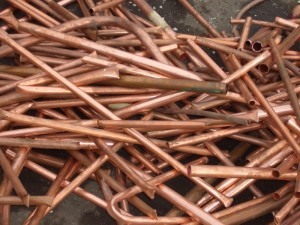later post | index | earlier post
Understanding Grades of Copper Scrap
Monday, 10 April 2017

Copper is among the most valuable metals available when it comes to scrap collection and recycling. With an infinite recyclable life, copper is used and reused in motors, computers, construction, industrial machinery and more. Whether you’re a collector or dealer of scrap in a hobbyist, part-time or professional capacity, a reliable method of sourcing quality copper scrap is a great thing to have.
However, the prices you can get depend largely on the grade of scrap copper that you carry. As different recycling centres and scrap dealerships tend to have their own prices based on their own classifications, it’s a good idea to know precisely what sets copper grades apart, as well as which of them provides the best overall value.
#2 Copper
This grade of copper can be identified by its somewhat dirty appearance. It should be comprised of miscellaneous unalloyed wire, pipe or solid metal that continues to have solder, paint or any kind of coating on it. Additionally, its minimum copper content should be 94-96%. In order to qualify for this grade, wire must be bare of insulation and be thinner than a 16th of an inch in diameter. The ends and fittings of #2 copper are generally accepted at dealerships, and oxidation of some wire, pipe or tubing is allowed as long as damage is not excessive.
#2 copper is the third most valuable grade available.
#1 Copper
#1 copper is the second most profitable type to trade in. To be classified as #1, the copper should be comprised of bus bars, clippings, commutator segments and wire of at least 1/16th of an inch in diameter. It should also be clean in appearance, unalloyed and uncoated.
The most valuable type of copper pipe – clean copper tubing – may qualify as #1 copper as long as it is free of fittings, insulation, paint, solder and other materials. In fact, most copper tubing and copper pipes can be of #1 grade providing they show few signs of corrosion and have their fittings removed. Trace amounts of oxidation on the tubing are generally acceptable.
Bare Bright Copper
Bare bright copper is by far the first among the types a scrap dealer would like to find. Also referred to as “bright & shiny copper,” it is the most valuable and high-paying grade around. It refers exclusively to bare, uncoated and unalloyed wire or cable – no thinner than 16 gauge in thickness – which is of #1 copper quality. Copper piping is not included within the classification.
As its name implies, samples must be stripped of insulation and other materials. Furthermore the metal must be free from any paint, impurities or signs of tarnishing. This includes any visible oxidation, and very negligible amounts of patina on the copper are allowable.
#2 Insulated Wire
#2 grade insulated copper consists of unalloyed wire – thinner than 16 gauge – which includes heavy, double or plastic insulation. The grade generally covers many common types of telecommunications wiring as well as electronics such as outlet and extension cords. Some coatings on the scrap, such as tin and nickel for example, as well as some degree of corrosion will also meet classification.
With its insulation removed, the wiring should look like #2 copper wire.
#1 Insulated Wire
#1 insulated wire consists of copper wire or cable which is clean, unalloyed, uncoated and untinned. It should also be plastic insulated, of 16 gauge thickness or larger, with all ends cut off. Though insulation does not need to be stripped, if it were the wire within should closely resemble ‘bright & shiny’ copper wire.
Armed with this information, you are in a good position to understand the expected value of the copper scrap in your possession. Checking prices at individual recycling companies and comparing the difference between their classifications and rates should ensure you receive the greatest possible reward for your effort.
later post | index | earlier post
Recent posts
- What is WEEE waste?
- Can iron be recycled in the UK?
- What has the most copper in it to scrap?
- How to better understand scrap metal pricing
- Is there a link between copper and brass prices?
- How to make money from cable scrap
- How many different types of copper are there?
- What can I sell to a scrap metal yard?
- Preparing for the collection of scrap metal
- How scrap metal prices have changed in the past decade
- The continued growth of scrap car recycling in the UK
- How To Dispose of Aerosol Cans in the UK
- What to do with radioactive scrap metal
- 5 common metals that can be recycled
- Where to sell scrap metal